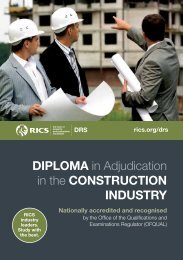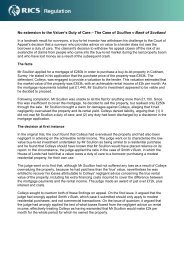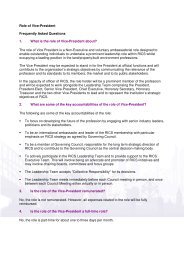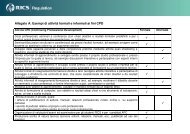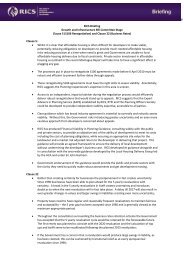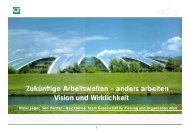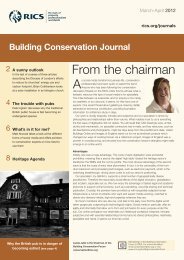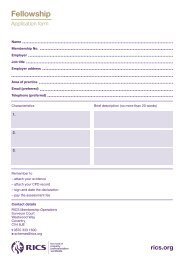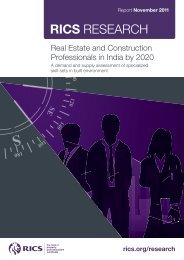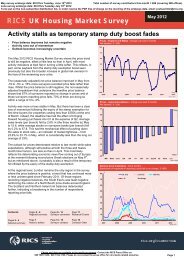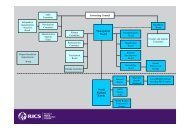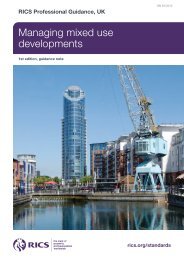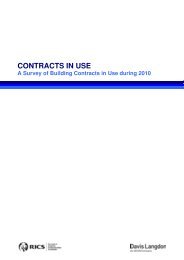SMM7 QUESTIONS & ANSWERS - RICS
SMM7 QUESTIONS & ANSWERS - RICS
SMM7 QUESTIONS & ANSWERS - RICS
You also want an ePaper? Increase the reach of your titles
YUMPU automatically turns print PDFs into web optimized ePapers that Google loves.
<strong>SMM7</strong> <strong>QUESTIONS</strong> & <strong>ANSWERS</strong><br />
by<br />
John Davidson F<strong>RICS</strong><br />
is a Director of Cyril Sweett and the Honorary Queries Secretary for the<br />
Standing Joint Committee for the Standard Method of Measurement<br />
and<br />
Paul Hambleton BSc F<strong>RICS</strong><br />
is a practising Quantity Surveyor with over 25 years’ industry experience
Acknowledgements<br />
The authors and publishers wish to thank the Standing Joint Committee for the Standard Method of<br />
Measurement for the use of material from the <strong>SMM7</strong> Standard Method of Measurement of Building<br />
Works and the <strong>SMM7</strong> Measurement Code.<br />
John Davidson would also like to thank his employer, Cyril Sweett Ltd, for their support during the<br />
writing of this book.<br />
Published by <strong>RICS</strong> Business Services Limited<br />
a wholly owned subsidiary of<br />
The Royal Institution of Chartered Surveyors<br />
under the <strong>RICS</strong> Books imprint<br />
Surveyor Court<br />
Westwood Business Park<br />
Coventry CV4 8JE<br />
UK<br />
www.ricsbooks.com<br />
No responsibility for loss or damage caused to any person acting or refraining from action as a result<br />
of the material included in this publication can be accepted by the author, publisher or <strong>RICS</strong>.<br />
ISBN 978 1 84219 228 0<br />
ISBN (prior to January 2007) 1 84219 228 0<br />
© <strong>RICS</strong> Business Services Limited (RBS) September 2006. Copyright in all or part of this publication<br />
rests with RBS, and save by prior consent of RBS, no part or parts shall be reproduced by any means<br />
electronic, mechanical, photocopying or otherwise, now known or to be devised.<br />
Typeset in Great Britain by Columns Design Ltd, Reading, Berks<br />
Printed in Great Britain by Cromwell Press,Trowbridge,Wiltshire
Contents<br />
Introduction v<br />
General Rules 1<br />
A Preliminaries/General conditions 5<br />
C Existing site/buildings/services 7<br />
D Groundwork 11<br />
E In situ concrete/Large precast concrete 23<br />
F Masonry 37<br />
G Structural/Carcassing metal/timber 45<br />
H Cladding/Covering 55<br />
J Waterproofing 65<br />
K Linings/Sheathing/Dry partitioning 67<br />
L Windows/Doors/Stairs 75<br />
M Surface finishes 77<br />
N Furniture/Equipment 93<br />
P Building fabric sundries 95<br />
Q Paving/Planting/Fencing/Site furniture 99<br />
R Disposal systems 101<br />
Y Mechanical and electrical services measurement 103<br />
page<br />
iii
Introduction<br />
This book <strong>SMM7</strong> Questions & Answers is a companion volume to the seventh edition of the Standard<br />
Method of Measurement (<strong>SMM7</strong>) and the <strong>SMM7</strong> Measurement Code. It has been written to try to assist<br />
in the interpretation of some of the more complex areas of measurement and work description.<br />
The authors hope that it will eliminate many of the arguments and disputes, and explain some of the<br />
more common misunderstandings which can arise on construction projects due to differences of<br />
interpretation. This text uses questions sent to the Standing Joint Committee (SJC) and their<br />
responses on live issues. For ease of understanding by the reader, questions and responses have been<br />
paraphrased and, where appropriate, combined with other similar questions.<br />
This book utilises diagrams in certain cases to clarify the question or the answer in relation to<br />
identify with the Standard Method of Measurement text.The book follows the structure of <strong>SMM7</strong> and<br />
its component chapters. However, because the book is based on actual questions submitted to the<br />
SJC for <strong>SMM7</strong>, not all sections are covered here.<br />
It is also important to recognise that <strong>SMM7</strong> and this book both deal with the measurement and<br />
description of construction work.Among the queries received by the SJC there are a number which<br />
do not fall within the committee’s remit; such as queries on landfill tax, on valuation methods for<br />
variations, or on actual rates set for jobs.These issues are not discussed in this text.<br />
How to use this book and its general layout<br />
The book is written in the same sequence as the Standard Method of Measurement (SMM). The<br />
chapters are those as set out in the SMM.To avoid confusion, the first section annotation is used for<br />
the questions and answers contained thereunder, the other headings listed in section are taken as<br />
being referred to by the first heading annotation. For example:<br />
F20 Natural stone rubble walling<br />
F21 Natural stone ashlar walling/dressings<br />
F22 Cast stone ashlar walling/dressings<br />
INFORMATION MEASUREMENT DEFINITION COVERAGE SUPPLEMENTARY<br />
PROVIDED RULES RULES RULES INFORMATION<br />
P1, P2, etc. M1, M2, etc. D1, D2, etc. C1, C2, etc. S1, S2, etc.<br />
CLASSIFICATION<br />
TABLE<br />
The questions and answers in this section are referenced as F20.1.1.1.1, Measurement Rule F20.M1,<br />
etc., for simplicity even if they may be specific to the other headings (i.e. F21, F22). Where detailed<br />
numbers such as F20.1.*.1 are used they refer to the numbered items in the Classification Table.<br />
(Note that ‘.*.’ corresponds to a blank column.)<br />
Occasionally a question is included in more than one section, typically where the Work Section in the<br />
answer is different from that raised in the question.<br />
v
<strong>SMM7</strong> Q & A<br />
Important notes<br />
Some <strong>SMM7</strong> Work Sections and subsections were renumbered and new Work Sections introduced in<br />
the 1998 Revision.These were Work Sections C, D, E F, G, H J, K, l, M, Q, and R.<br />
All <strong>SMM7</strong> references refer to the current edition, i.e. the Seventh Edition Revised 1998, incorporating<br />
Amendments 1 and 2.<br />
The interpretation of the rules of <strong>SMM7</strong> are those of the authors but are based on replies made<br />
under the auspices of the SJC.<br />
All answers given in this book assume strict interpretation of the rules of measurement contained<br />
within <strong>SMM7</strong>.This may mean that some answers appear to be extremely pedantic. Surveyors are free<br />
to measure any item of work in any other way they may think appropriate provided they insert an<br />
explanatory note or qualification in the Bill(s) of quantities clearly describing their intentions.<br />
NOTE: No work can be deemed included, irrespective of what the measurement rules say, unless it<br />
can be seen on the drawings or understood from the specification or by reference to a catalogue or<br />
other standard specification, such as a British Standard, that can be easily obtained by the estimator<br />
when pricing the Bills of quantities.<br />
Symbols and abbreviations<br />
The following symbols and abbreviations are used in this book.<br />
AI = architect’s instruction<br />
BoQ(s) = Bill(s) of quantities (other common abbreviations are BofQ and BQ)<br />
BWIC = builders’ work in connection<br />
DPC = damp-proof course<br />
DPM = damp-proof membrane<br />
EO = extra over<br />
EWS = earth work support<br />
h = hour<br />
kg = kilogramme<br />
m = metre<br />
m 2 = square metre<br />
m 3 = cubic metre<br />
mm = millimetre<br />
NBS = National Building Specification<br />
n.e. or n/e = not exceeding<br />
nr = number<br />
o/a = overall<br />
pc sum = prime cost sum<br />
prov sum = provisional sum<br />
QS = quantity surveyor<br />
t = tonne<br />
= exceeding<br />
= equal to or exceeding<br />
= not exceeding<br />
= less than<br />
% = percentage<br />
.*. = blank column<br />
vi
The book references rules using the Work Section and Rule number, e.g. Measurement Rule F10.M1.<br />
Classification Table Rules are referenced by the Work Section then column numbers from left to<br />
right, e.g. F10.1.1.1, H10.3.*.1,Y10.9.1.<br />
Publications referred to regularly in this book are abbreviated as follows:<br />
<strong>SMM7</strong> Standard Method of Measurement of Building Works (7th edition), revised 1998<br />
incorporating Amendments 1 and 2 (May 2000)<br />
Measurement Code <strong>SMM7</strong> Measurement Code: A Code of Procedure for Measurement of Building<br />
Works, revised 1998 incorporating Amendments 1 and 2 (January 2000)<br />
CAWS Common Arrangement for Building Works (2nd edition), 1998<br />
Introduction<br />
vii
General Rules<br />
1 Introduction<br />
Do departures from the rules of <strong>SMM7</strong> need<br />
to be specifically referred to if made when<br />
preparing a BoQ?<br />
2 Use of the tabulated rules<br />
If the employer requires such items as spare<br />
carpet tiles, raised floor panels or suspended<br />
ceiling tiles to be provided should specific<br />
items be measured? <strong>SMM7</strong> appears silent on<br />
this matter.<br />
If relevant information is not given in the BoQ<br />
description, whether as part of the worded<br />
description, by a unique cross reference or by a<br />
drawing reference, does this constitute a Bill<br />
error?<br />
4 Descriptions<br />
A Bill description relies on a reference to a<br />
drawing to describe a composite item. After<br />
tender a conflict is discovered between the<br />
drawn information and the Bill description.<br />
Which takes priority?<br />
Where drawings are being relied upon to<br />
define the location, scope and extent of work<br />
to be included as a provisional sum in a BoQ,<br />
must these drawings be specifically referred to<br />
in the description of the provisional sum or is it<br />
sufficient for these drawings to be listed only as<br />
tender drawings?<br />
Can a ‘unique and precise’ cross reference be<br />
given as part of the information required by<br />
General Rule 4?<br />
Yes, all departures must be clearly set out in<br />
the BoQ.<br />
Yes, General Rule 2.5 reminds us that the rules<br />
do not cover every event therefore, in<br />
accordance with General Rule 11.1, the<br />
surveyor must adapt rules for similar work<br />
accordingly.<br />
Yes, General Rules 2 and 4 set out what<br />
minimum information must be given when<br />
composing Bill descriptions.<br />
The drawn information will always take<br />
priority. If a discrepancy is found in a Bill item it<br />
must be remeasured in accordance with the<br />
drawing or the executed work.<br />
General Rule 4.2 is quite specific in requiring a<br />
cross reference to be given in the description<br />
when using drawn information in lieu of a<br />
written description.<br />
Yes.<br />
1
<strong>SMM7</strong> Q & A<br />
A ‘saluting base’ is measured as a composite<br />
item with reference to a drawing. It is to be<br />
constructed mainly of stainless steel and glass.<br />
Is it reasonable to assume the ‘plate glass’ to be<br />
included in BoQ item which reads ‘stainless<br />
steel saluting base, Drawing No. [XX]’? There is<br />
no mention of glass in the remainder of the<br />
BoQ description and very limited reference to<br />
glass on the drawing.<br />
9 Composite items<br />
A BoQ description reads as follows – ‘Timber<br />
framed laylight as specification Clause L40.211;<br />
wrot softwood; double glazed units; all<br />
decoration; as Architect’s drawings X and Y’.<br />
Should the BoQ description be held to include<br />
an aluminium rooflight because it is shown on<br />
the drawings?<br />
The BoQ description and specification<br />
reference make no reference to an aluminium<br />
rooflight within the timber framed laylight.The<br />
drawings do show an aluminium rooflight.<br />
If a provisional sum is ‘undefined’, must the<br />
contractor allow for percentage profit if there<br />
is such an item included in the BoQ for a sum<br />
to be inserted?<br />
2<br />
No, the item does not comply with the<br />
requirements of General Rules 4.2 and 9.1.<br />
General Rule 4.2 does not allow the<br />
aggregation of a number of measured items<br />
which are otherwise required to be measured<br />
separately.Also the construction shown on the<br />
drawing would not be considered as a<br />
composite item as it would be difficult to<br />
construct and assemble off site and reassemble<br />
on site.<br />
No, General Rule 4.2 does not permit the<br />
aggregation of items. The BoQ item has not<br />
been qualified and therefore cannot be held to<br />
contain anything other than the timber frame.<br />
The use of a unique specification reference<br />
does not automatically mean that every item<br />
contained in the specification item is to be<br />
taken as being measured in the Bill description.<br />
General Rule 9.1 defines composite items and<br />
this Bill description does not comply with that<br />
definition.<br />
10 Procedure where the drawn and specification<br />
information required by these rules is not available<br />
Can a provisional sum be described as ‘defined’<br />
if not all of the information is given as required<br />
by General Rule 10.3?<br />
If a provisional sum is ‘undefined’, should the<br />
tenderer be held to have made allowances in<br />
the Preliminaries for programming, planning,<br />
etc?<br />
No, all relevant information required by<br />
General Rule 10.3 must be given for a<br />
provisional sum to be described as ‘defined’.<br />
No, see General Rule 10.6 and Clause 10, page<br />
13 of the Measurement Code.<br />
Yes, as long as General Rules 10.2 to 10.6<br />
inclusive are properly qualified in the BoQ.<br />
Normally the amount given to a provisional<br />
sum includes an allowance for ‘profit’.




